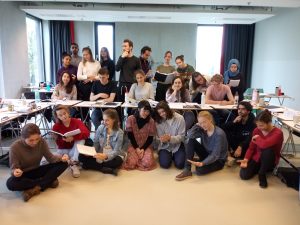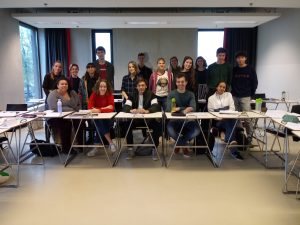Creative writing professor Laura Wetherington teaches at Amsterdam University College in the Netherlands. This week, her students will be reading the SmokeLong queue, discussing the stories and selecting a favorite for us to publish. We talked with Laura about her classes and what she hopes the students get out of reading our submission queue.
 What can you tell us about your college?
What can you tell us about your college?
Amsterdam University College (AUC) is now in its tenth year. It’s a small, liberal arts honors college developed in partnership between the University of Amsterdam and Vrije Universiteit Amsterdam. The coursework is in English, a second language for many of our students (though it’s tough to tell that by reading their work.) Creative writing is not available as a major, so all of the students in the class are taking it either as an elective or as part of a concentration cluster within Humanities. The school is bent toward experiential learning, so guest editing for y’all is a perfect fit for us.
 What is the creative writing course structure?
What is the creative writing course structure?
Because of the way accreditation works in the Netherlands (and perhaps because of the Dutch poldermodel), course curriculum is developed once by the teachers who will teach the class, and then is reviewed and amended collaboratively each semester. What this means is that I inherited the creative writing course structure from Wade Geary and Huan Hsu, including all the readings and assignments. (You can see their interview here about guest editing for SmokeLong.)
Intro to creative writing has three genres: poetry, fiction, and nonfiction, though initially we de-emphasize the distinction. In the first half of the semester there is no workshop. Instead, in a series of in-class writings and homework assignments, the class emphasizes exploration, finding your obsessions, and messy drafting. At the mid-point, right before students begin whole-class workshops, they guest edit SmokeLong Quarterly.
What they workshop comes from the messy drafting in the first half of the course and gets further expanded and revised after workshop, based on the feedback. So this mid-point turn in the semester gives the students a chance to see a wide range of contemporary models just as they’re beginning to revise and tinker with an audience in mind.
The structure of this course is ingenious and I’d love to adapt it for all my intro classes from now on. Reading for SmokeLong goes beyond what students get out of a mock workshop. By guest editing, students gel together as a critique group, and they begin to understand the diversity of literary traditions and approaches by way of a slush pile. Last semester there were upwards of 80 submissions! The students learn what they do and don’t want to imitate. They realize that they could be swayed by seeing a piece through their classmates’ eyes, that there isn’t a “best” as much as an individual’s preferences, and their own criteria for good writing have to be well-articulated and persuasive.
I love that you initially de-emphasize the distinctions between poetry, fiction, and nonfiction in the course. Can you talk a little about how that influences the work your students produce? I’m also curious if you bring this de-emphasis into your own writing?
This is a great question, and one I wasn’t sure I could totally answer myself, so I asked the students. Some of them said they already have notions about fiction or creative nonfiction or poetry because they were writing before the class started and so they end up producing what they already knew. Some students remarked that talking more explicitly about form later helped them feel more accomplished with the writing they’re doing because they knew they were sticking to a set of guidelines. Some said they felt less restricted than usual with the earlier, genre-less prompts (which was a good thing), but then felt a bit awkward when more limitations creeped into the assignments. Other folks piped in at that point and said that limitations make writing easier for them, and this is why I love the creative writing classroom! Everyone needs something different, and the hope is that the first part of the course gives the students the opportunity to explore what works best for them.
In the first four weeks we look at a lot of writing models across genres, and study the structure or rhythm or point of view of the piece without talking about what to call it. So some students, for example, are really shocked to find out in week six that the short prose piece we read in week four, “The Black Object’s Elasticity” by Ronaldo V. Wilson, is from a book called Poems of the Black Object.
Now that I’m reading the students’ personal essays — the last assignment before we begin to revise for workshop and after we’ve talked about elements of the three genres — I can say their writing at this stage feels more sophisticated perhaps because the students are combining techniques from all three genres; one student wrote a call-and-response kind of essay that talks about song and feels a lot like poetry, another focused heavily on dialogue and scene-setting, essentially writing a story. Some folks called home to interview a parent, or studied images, or conducted some other form of research to help fill in their memories.
I feel really lucky that the class is structured in this way because I do prefer to read (and sometimes write!) things that blend or bend genre and experiment with form.
You mentioned using a series of in-class writing assignments. I know a lot of writers (myself included) love a good writing prompt. Is there is a favorite from the class that you can share with our readers?
My favorite in-class assignment occurs in week two. Many of these students are in the sciences, so this exercise is tailored for them. We start class with them drawing one another’s eyes (mostly as a way to begin to get comfortable with discomfort.) Then I ask them how many folks believe it’s possible to feel a person staring at them, I mean that feeling where your hair stands up and you whip your head around and meet someone’s eyes. Every time at least half the class raises their hands. We then talk a bit about the theories of vision through history ending with Johannes Kepler, who theorized that light enters the eye (and nothing leaves it.) If that’s true, though, how do we sense being stared at, I ask? The students have a variety of plausible (and some wild!) explanations. They then write something creative that includes their theory of whether feeling being stared at is possible. At the end of the exercise I tell them that writing can be a way of trying to understand big questions they don’t have the answer to. Anything can go in there!
The prompt for people here: make a list of big questions you don’t have the answer to (how can we sense being stared at if nothing leaves the eye? are we alone in the universe? how can we solve climate change?) then write a piece that creates a plausible (or wild!) answer to one of the questions.

 The core workshop of SmokeLong Fitness is all in writing, so you can take part from anywhere at anytime. We are excited about creating a supportive, consistent and structured environment for flash writers to work on their craft in a community. We are thrilled and proud to say that our workshop participants have won, placed, or been listed in every major flash competition. Community works.
The core workshop of SmokeLong Fitness is all in writing, so you can take part from anywhere at anytime. We are excited about creating a supportive, consistent and structured environment for flash writers to work on their craft in a community. We are thrilled and proud to say that our workshop participants have won, placed, or been listed in every major flash competition. Community works.